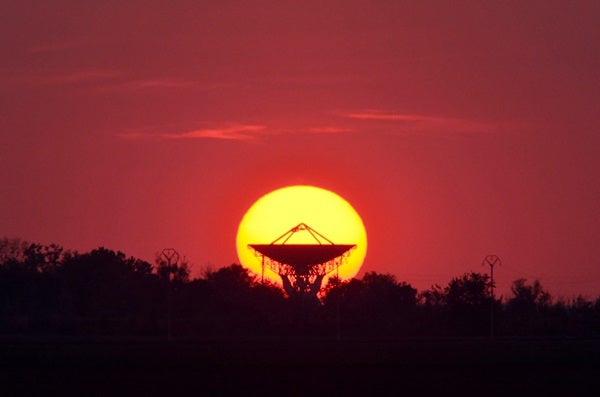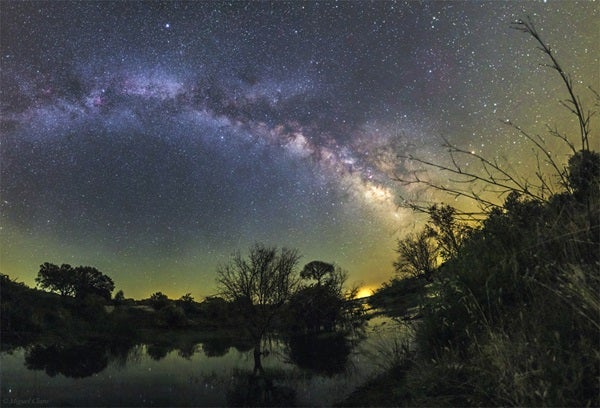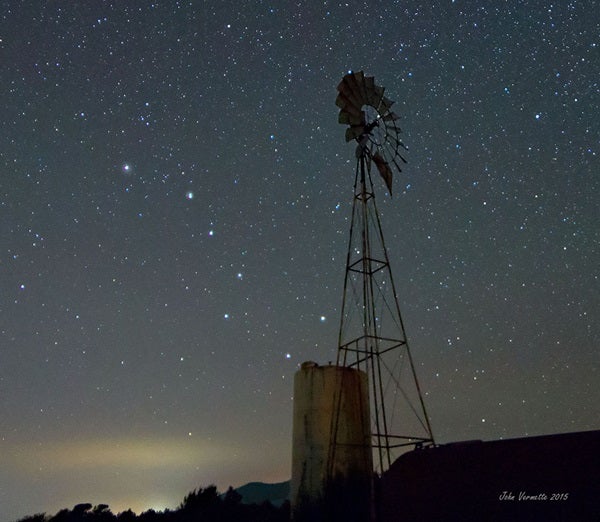Observers of the outer solar system can now get a good view of Uranus during the late evening hours. The ice giant planet rises shortly after 10 p.m. local daylight time and climbs 20° high in the east by midnight. It reaches its peak about 60° above the southern horizon around the start of morning twilight. Uranus glows at magnitude 5.7 against the backdrop of southern Aries the Ram. Use binoculars to find the planet 2.3° south-southeast of the similarly bright star 19 Arietis. A telescope reveals Uranus’ blue-green disk, which spans 3.6″.
Saturday, August 24
Look for the waning crescent Moon this morning as it hovers just east of the Hyades star cluster in Taurus the Bull. The two objects clear the horizon by 1 a.m. local daylight time and climb halfway to the zenith by the time morning twilight begins. The Moon appears about 40 percent lit and easily outshines the stars of the V-shaped Hyades. First-magnitude Aldebaran, which marks one tip of the V, appears brighter than the rest of the cluster’s stars because it actually lies in the foreground.
Sunday, August 25
Jupiter continues to dominate the evening sky from its perch in southern Ophiuchus the Serpent-bearer. The giant planet shines at magnitude –2.3 and stands some 25° high in the south-southwest as twilight fades to darkness. When viewed through a telescope, the planet shows a 40″-diameter disk and striking cloud-top detail. As a bonus, Jupiter currently appears near the edge of the 10th-magnitude globular star cluster NGC 6235. The planet’s slow eastward motion relative to the background stars carries it across the cluster’s southern perimeter from this evening through the 27th. Although the giant world’s brilliance renders NGC 6235 barely visible through most telescopes, imagers should be able to capture both.
Mars reaches the farthest point in its orbit around the Sun at 9 p.m. EDT. At this so-called aphelion, the Red Planet lies 154.9 million miles (249.2 million km) from our star. Mars is now lost in the solar glare, but it will return to view this fall to start an impressive apparition that will culminate in October 2020.
Monday, August 26
Asteroid 15 Eunomia reached opposition and peak visibility just two weeks ago, and it remains a tempting target. The main-belt object traverses the sky from dusk to dawn and climbs halfway to the zenith in the southern sky around midnight local daylight time. Eunomia shines at magnitude 8.4 and should be easy to find through binoculars under a dark sky and in a 4-inch telescope from the suburbs. The asteroid lies among the background stars of Aquarius the Water-bearer, some 7° west of magnitude 2.9 Beta (β) Aquarii. But 6th-magnitude 12 Aqr provides an even better guide. This evening, Eunomia slides 0.1° south of this star.
Tuesday, August 27
Distant Neptune reaches opposition and peak visibility one week from today, but the view now is essentially the same. The ice giant planet rises during evening twilight and climbs halfway to the zenith in the southern sky by 2 a.m. local daylight time. The magnitude 7.8 planet lies in Aquarius, just 0.25° east-northeast of 4th-magnitude Phi (φ) Aquarii. You’ll need binoculars to spy Neptune and a telescope to see its blue-gray disk, which spans 2.4″.
If you look overhead as darkness falls anytime this week, your eyes will fall on the brilliant star Vega in the constellation Lyra the Harp. At magnitude 0.0, Vega is the brightest member of the prominent Summer Triangle asterism. The triangle’s second-brightest star, magnitude 0.8 Altair in Aquila the Eagle, lies some 35° southeast of Vega. The asterism’s dimmest member, magnitude 1.3 Deneb in Cygnus the Swan, stands about 25° east-northeast of Vega. Deneb trails Vega by about two hours and passes through the zenith at approximately 11 p.m. local daylight time.
Thursday, August 29
Magnificent Saturn reached its peak seven weeks ago, when it appeared opposite the Sun in the sky, and our view of the ringed planet remains spectacular. It resides among the background stars of Sagittarius the Archer, a region that appears highest in the south around 9:30 p.m. local daylight time and doesn’t set until 2 a.m. Saturn continues to shine brightly, too, at magnitude 0.3. When viewed through a telescope, the planet’s disk measures 18″ across while the dramatic ring system spans 40″ and tilts 25° to our line of sight.
Friday, August 30
New Moon occurs at 6:37 a.m. EDT. At its New phase, the Moon crosses the sky with the Sun and so remains hidden by our star. Because the Moon reaches perigee, the closest point in its orbit around Earth, only five hours later (at 11:53 a.m. EDT), residents in coastal areas can expect higher than normal tides for the next few days. At perigee, the center of the Moon lies 221,939 miles (357,176 kilometers) from Earth’s center.
The constellations Ursa Major the Great Bear and Cassiopeia the Queen lie on opposite sides of the North Celestial Pole, so they pivot around the North Star (Polaris) throughout the course of the night and the year. In late August and early September, these two constellations appear equally high as darkness falls. You can find Ursa Major and its prominent asterism, the Big Dipper, about 30° above the northwestern horizon. Cassiopeia’s familiar W-shape, which currently lies on its side, appears the same height above the northeastern horizon. As the night progresses, Cassiopeia climbs above Polaris while the Big Dipper swings below it.
Sunday, September 1
The Aurigid meteor shower peaks this morning, with the best views coming when the radiant (which lies in the constellation Auriga) climbs high before dawn. Although this minor shower typically produces only 6 meteors per hour under optimal conditions, it occasionally performs much better. Rates six times higher than normal occurred in 1935, 1986, and 1994, and viewers recorded up to 130 meteors per hour for a brief stretch in 2007. No one knows when the shower will burst out again, but conditions should be nearly perfect this year with the Moon absent from the morning sky.












